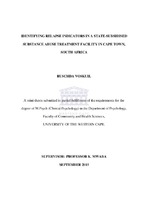| dc.contributor.advisor | Mwaba, K. | |
| dc.contributor.author | Voskuil, Ruschda | |
| dc.date.accessioned | 2016-01-08T07:29:49Z | |
| dc.date.available | 2016-01-08T07:29:49Z | |
| dc.date.issued | 2015 | |
| dc.identifier.uri | http://hdl.handle.net/11394/4714 | |
| dc.description | Magister Psychologiae - MPsych | en_US |
| dc.description.abstract | Substance abuse has been identified internationally and in South Africa as an escalating problem that has harmful effects on the substance user and on society. The cost of treating substance-related disorders places a strain on the allocation of financial resources to treat the problem. When relapse occurs in substance users who have already undergone rehabilitation, it increases the costs of treatment. Waiting lists at treatment centres are also negatively affected for first-time admissions when relapsed substance users are re-admitted. The study aimed to identify relapse indicators by post-discharge follow-up of adult substance users in a
registered, non-profit, state-subsidised treatment facility in Cape Town. Marlatt’s Dynamic model of relapse was used to explore the individual and socio-cultural factors which were potentially associated with relapse. A quantitative research design using archival data and purposive sampling was used to identify possible relapse indicators. The participants were ex-patients who had undergone an inpatient treatment programme and who had been followed up post discharge. Ethical clearance was obtained from the University of the Western Cape Higher Degrees Committee. Written permission was granted by the treatment centre who is the original data owner.The majority of participants were male. More than half
of the sample reported polysubstance use and, for more than half of them, the age of onset of substance use was between 11 and 15 years. Severe depression was present for more than a third of the participants, whilst the majority of the sample was assessed as being substance dependent. A large proportion of patients had family members who also used substances. The majority of the sample was unemployed and more than half had received previous substance abuse treatment. Significant associations were not established between the identified variables within the groups of factors. Additional studies are required to explore the factors
contributing to relapse in this patient population. | en_US |
| dc.language.iso | en | en_US |
| dc.publisher | University of the Western Cape | en_US |
| dc.subject | Substance abuse | en_US |
| dc.subject | Relapse indicators | en_US |
| dc.subject | Aftercare | en_US |
| dc.subject | Western Cape | en_US |
| dc.title | Identifying relapse indicators in a state-subsidised substance abuse treatment facility in Cape Town, South Africa | en_US |
| dc.rights.holder | University of the Western Cape | en_US |

